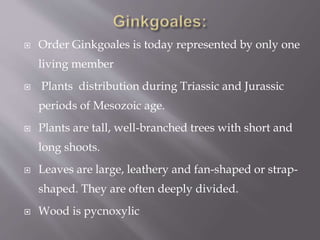Gymnosperm Orders.pptx
- 1. Gymnosperms Orders & their examples Dr. Sonali Randive-Aherkar
- 3. Cycadales, consisting of 11 living genera and more than 100 species. Members of cycadels are distributed in both tropical and warm temperate regions of the world. The plant body is sporophytic. The sporophyte is differentiated into roots, un- branched stem and pinnately compound leaves.
- 4. Members exhibit xerophytic characters. Young leaves show circinate vernation. The leaf trace is diploxylic Plants are dioecious The cones are generally terminal or lateral Microsporangia are arranged on the abaxial side of the microsporophyll’s. Megasporophylls are foliage leaf-like structures.
- 5. Kingdom: Plantae Subkingdom: Tracheophytes Division: Cycadophyta Class: Cycadopsida Order: Cycadales Family: Zamiaceae Genus: Zamia
- 7. Coniferales shows presence of 54 living genera & more than 500 species. Main plant body is sporophytic. Sporophyte is divided in to root, stem & branches. They are found from Carboniferous to the present times. Branches are dimorphic. Leaves are of two types, i.e. foliage leaves and scaly leaves
- 8. Leaves are arranged spirally. Plants are either monoecious or dioecious. Reproductive organs are unisexual cones. The sporophylls are generally arranged in the form of cones. Pollen grains may be winged. The female cone consist of many sterile bract scales and fertile ovuliferous scales. Seeds are endospermic and winged
- 9. Kingdom: Plantae Subkingdom:Tracheophytes Division: Pinophyta Class: Pinopsida Order: Pinales Family: Araucariaceae Genus: Araucaria
- 11. Kingdom: Plantae Subkingdom: Tracheophytes Division: Pinophyta Class: Pinopsida Order: Pinales Family: Podocarpaceae Genus: Podocarpus
- 13. Kingdom: Plantae Subdivision: Tracheophytes Division: Pinophyta Class: Pinopsida Order: Pinales Family: Cupressaceae Genus: Cupressus
- 15. Order Ginkgoales is today represented by only one living member Plants distribution during Triassic and Jurassic periods of Mesozoic age. Plants are tall, well-branched trees with short and long shoots. Leaves are large, leathery and fan-shaped or strap- shaped. They are often deeply divided. Wood is pycnoxylic
- 16. Male organs are catkin-like, present in axillary position Each micro-sporangiophore possesses 2-12 pendulous microsporangia. Ovules are terminal in position, 2-20 in number.
- 17. Kingdom: Plantae Subkingdom: Tracheophytes Division: Ginkgophyta Class: Ginkgoopsida Order: Ginkgoales Family: Ginkgoaceae Genus: Ginkgo Species: biloba
- 18. Habit Leaf Structure Fruits Male & Female cone
- 19. Taxales shows 5 living genera and 200 species Professor Birbal Sahni (1920), who suggested that Cephalotaxus, Taxus and Torreya should be treated under Taxales. Members are tree or small shrub. Plant body is sporophytic Plants are evergreen The leaves are simple, linear with acute apex Leaves are spirally arranged on the branches.
- 20. Plants are mostly unisexual. Micro-sporangiophores are arranged in the form of small cones. The ovule is solitary and borne terminally on a dwarf shoot. An aril is present at the base of each ovule. The secondary wood is compact and pycnoxylic. The seeds are endospermic.
- 21. Kingdom: Plantae Subkingdom: Tracheophytes Division: Pinophyta Class: Pinopsida Order: Pinales Family: Taxaceae Genus: Taxus
- 22. Habit Leaves with sporangia Fruits Leaf Structure
- 23. Family Ephedraceae and order Ephedrales, is represented by 50 species. These species grow in dry climate. The plant body is sporophytic. Mostly the plants are woody shrubs, some are lianas, and small trees. Shows a prominent underground tap root system. stem is green, ribbed, branched, fluted and differentiated into nodes and internodes
- 24. Leaves are small scaly, are arranged in opposite decussate manner. Ephedra is heterosporous These flowers are present in the form of cone like compound strobili. Male strobili arise in clusters from the nodes of the branches. Strobilus is rounded, ovoid or spherical in shape
- 25. Female strobilus usually arise in pairs at each node in the axil of scale leaves Female strobilus appears to be an elliptical structure with a pointed apex.
- 26. Kingdom: Plantae Subdivision: Tracheophytes Division: Gnetophyta Class: Gnetopsida Order: Ephedrales Family: Ephedraceae Genus: Ephedra
- 28. Habit Male Cone Equisetifolium shoots Female Cone Fruits




























